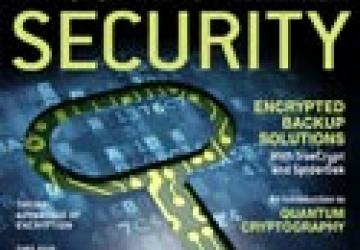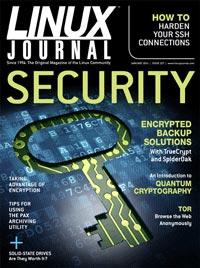January 2014 Issue of Linux Journal: Security


Lapsang Souchong!
Back when we were kids, "security" meant little more than having a secret password to keep little siblings out of the treehouse. That's still the case in some situations. Take the title of this column, for instance. If you go to the #linuxjournal IRC channel on FreeNode, saying "Lapsang Souchong" will mark you as part of the inner circle. (Note, this does not make you one of the cool kids...possibly the exact opposite!)
When it comes to computer security, however, things are quite a bit more complex. Whether you want to encrypt your data or lock down network access, Linux provides a wide variety of security tools. This month, we focus on using those tools in our Security issue.
Reuven M. Lerner starts off the issue with instructions on how to integrate Twitter into your applications. Whether you need your app to tweet results, error messages or automatic cat photos, Reuven walks through implementing the API. Dave Taylor follows up with a tutorial on using the ImageMagick suite to watermark and copyright photos. Since I use ImageMagick extensively with my BirdCam project (which you'll hear more about in a month or so), I found his column particularly interesting. If you need to work with photos, especially if direct interaction isn't possible, Dave's column will be interesting for you too.
Kyle Rankin gets into the security mindset this month by approaching privacy. Specifically, he explains how to set up Tor in order to browse the Web in private. Tor is just as useful as it once was, but thankfully, it's gotten easier and easier to implement. I follow Kyle's column with The Open Source Classroom, and this month, I talk about file encryption. Many people are intimidated by the notion of encryption, but it doesn't have to be scary. This month, we'll do just enough encryption to wet your whistle, and hopefully get you interested in learning more.
Although I may have introduced encryption in my column, Subhendu Bera takes things to a whole new level with Quantum Cryptography. Mathematics-based encryption is complex, for sure, but will it be enough as technology advances? Subhendu gives an explanation of Quantum Cryptography and a quick lesson in Quantum Mechanics as well. If you're interested in the future of cryptography, you'll love his article.
Remember Telnet? Telnet has been replaced in almost every situation by the much more secure SSH protocol. Granted, there still are a few situations that warrant the use of Telnet, but those generally are inside your network and never over the Internet. Just switching to SSH, however, isn't enough to ensure that you're secure. Sure, the connection itself is encrypted, but what if you have a user with a simplistic password? Or a script kiddie scanning for vulnerabilities? Federico Kereki describes how to harden SSH this month, making the wonderful and flexible SSH protocol a little safer to use. Whether you want to limit your allowed users or disable password connections altogether, Federico's article will guide you down the path of better SSH.
I may have started this issue with the basics of file and disk encryption, but if you are looking for more, Tim Cordova is about to be your favorite person. Going far beyond single file or even removable drive encryption, Tim shows how to encrypt your entire hard drive. Then, Tim goes even further and explains how to configure TrueCrypt in conjunction with SpiderOak to make sure your data is not only encrypted, but backed up as well! If you're interested in privacy and encryption, don't miss this article.
We finish off the security issue with Brian Trapp's article on solid-state drives. SSDs have been around for a number of years now, and we're finally to the point that we can provide some longevity statistics and reliability information. Have you been avoiding SSDs because you thought they would wear out? Did you think they had a significantly higher failure rate? Were you worried that you need Windows-specific drivers to make them work? Brian assuages many of those fears and validates those that are valid. SSDs are fast, and they can provide an incredible performance boost in most situations. You owe it to yourself to see if your scenario warrants an SSD. Brian's article will help.
This issue also contains tons of other Linux goodies. We have product announcements, opinion pieces and even fractals. You don't have to be one of the cool kids to enjoy this issue of Linux Journal, but it helps to be one of the smart kids. Thankfully, our readers tend to have that attribute in plentiful supply. We hope you enjoy this issue as much as we enjoyed putting it together.
Available to Subscribers: January 1










